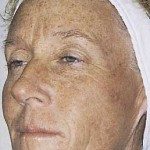What is it?
Excessive sun exposure over the years can result in sagging skin, unwanted lines and wrinkles and an increased risk of cancer. The harmful ultraviolet rays of the sun can penetrate deep beneath our skin’s surface to leave our skin sensitive and vulnerable to other environmental hazards.
Some of the common sun damaged skin conditions are:
- Actinic Keratosis – Actinic keratosis is a precancerous growth on the skin. You may notice a rough and dry skin lesion, patch or growth on the skin. It is usually localized to one area and can be on the face, scalp, back of the hands, chest or other sun-exposed areas. They can be gray, pink, red or the same color as the skin. It usually begins as a flat and scaly area which later develops a hard and wart-like, rough surface. The skin lesion may be easier to feel than see.
- Lentigines – Sun spots, also known as lentigines, are discolorations of the skin that most often appear on the back of the hands, neck and face in people who are usually over 30 years of age. Although harmless, sun spots can be an embarrassment, they do not need to be medically treated unless they are growing in size or changing in color.
- Seborrheic Keratosis – Seborrheic keratosis are noncancerous (benign) wart-like growths on the surface of the skin. They are located on the face, chest, shoulders, back, or other areas and are normally painless, but may become irritated and itch. They can be yellow, brown, black or other colors and have a slightly elevated, flat surface. These growths may have a rough or wart-like texture and often have a waxy surface. They may have a “pasted-on” appearance. There may just be one growth, however there are usually multiple growths.
What are the causes?
Sun damage occurs with prolonged exposure to the sun over the years. Although they might not appear at first, sun spots and other growths tend to form at a later age as the sun damage has accumulated for many years.
How can it be prevented?
The best way to prevent sun damage is to use sunscreen each time you’re out in the sun and to avoid unnecessary or prolonged sun exposure.
What are the treatments?
Sunspots can be treated with prescription medications such as alpha hydroxy acid gel, beta hydroxy acid gel and Retin-A. They can also be treated with an alpha hydroxy acid peel and other medical strength peels offered at our clinic. Other sun damage conditions can be improved by many of the laser and rejuvenating skin treatments including laser resurfacing, rejuvenating peels and Intense Pulse Light (IPL) treatments.
